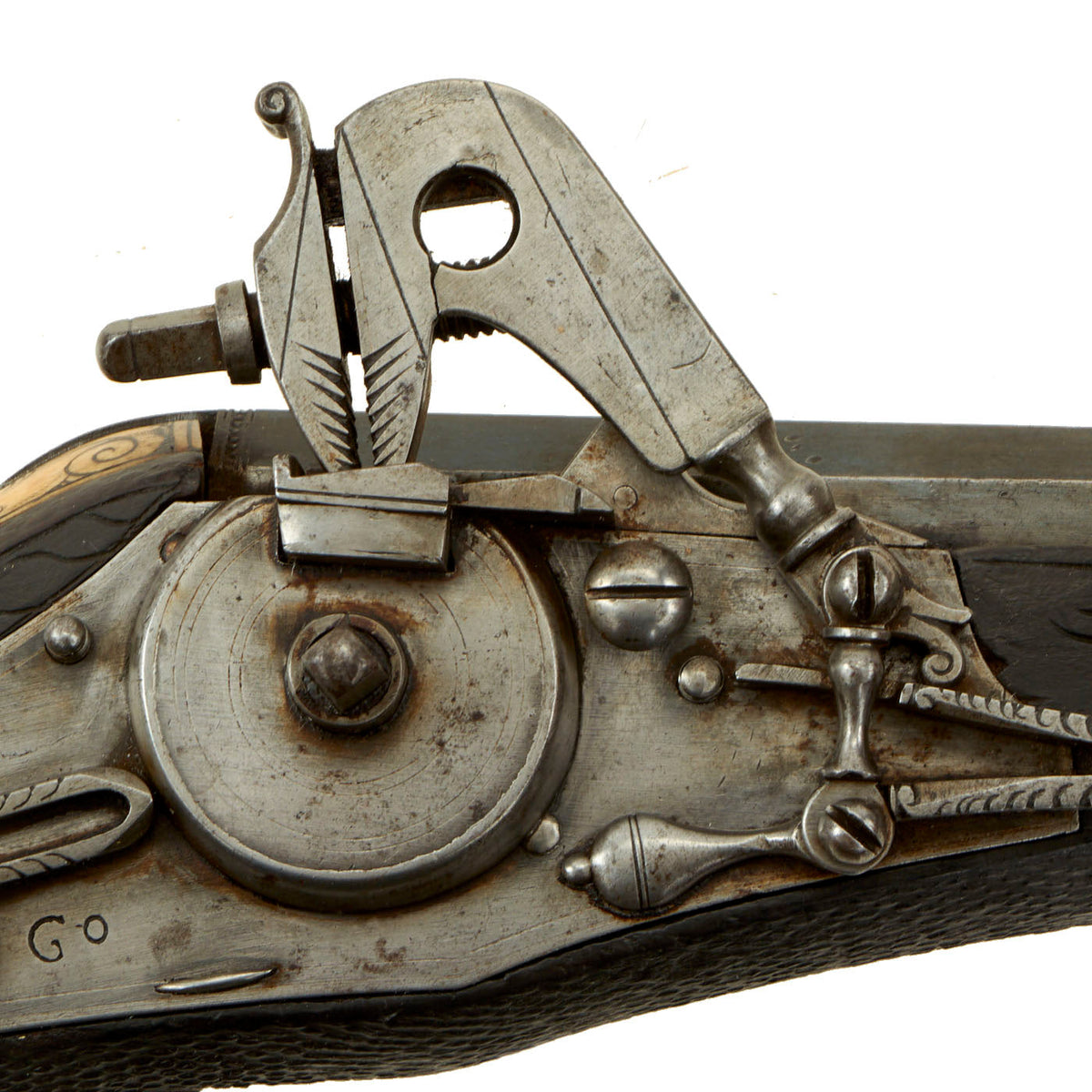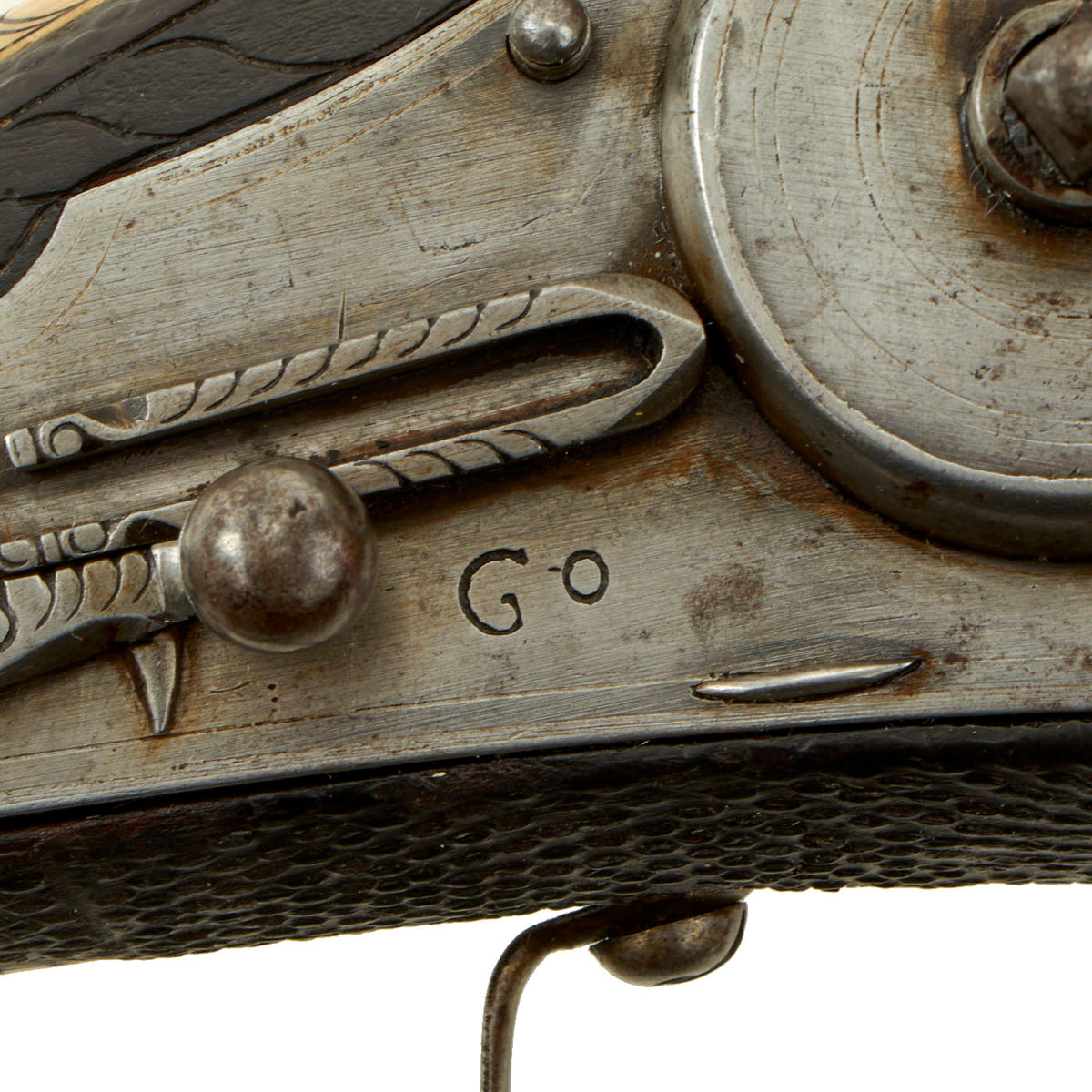Original 1591 Dated German Wheellock Puffer Holster Pistol from the Electorate of Saxony Trabanten Guard Original Items
$ 39.995,00 $ 9.998,75
Original Item: One-of-a-kind. Incredible 1591 dated Wheellock Puffer Pistol of the Saxon Trabanten Guards, the lifeguards of the Elector of Saxony, most likely for Christian II who became the elector in 1591 and reigned until his early death in 1611. This very pistol was in the collection of the Royal House of Saxony, House of Wettin Albertine Line, until sold in the 21st century.
This is a magnificent example of a late 16th century German wheellock pistol, which at the time was cutting edge technology. The complexity of the action in these pistols is truly astounding. They were definitely high end items, and usually bear high levels of decoration fitting of an item that only the wealthy could afford.
Our example originates from independent German Electorate of Saxony, which at the time was under the rule of Elector Christian the First 1560 – 1591. He ruled from the new capital of Dresden, the seat of the Elector since 1547. After his death he was succeeded by his 8 year old son, Christian the Second, who reigned from 1591 until his death in 1611. Saxony was a protestant state and had been very much concerned by the Ottoman influence emanating from Turkey, which culminated in the Siege of Vienna in the 1680’s.
The Electorate of Saxony was quite wealthy, and equipped the Guard of the Elector very lavishly with weapons and armor of tremendous quality, as well as high levels of decoration. This pistol is one such example, and bears the Coat of Arms of the electorate engraved on a stag horn disk mounted on the end of the ball-shaped butt stock.
Measuring 22 1/2 inches in overall length, the pistol features a 13 inch long half octagonal barrel, which has a lovely blued finish. It is dated 1 * 5 * 9 * 1 on the top facet. As with all wheellock pistols, it has very complicated steel and iron lock mechanism, at the time the ultimate technology. It is marked with G o on the lock, which is repeated on the top of the barrel breech. We assume this is a maker marking, however we have not been able to identify the maker.
The metalwork is mounted in a black checkered hardwood stock, beautifully decorated with hand engraved stag horn. This puffer features decorative work such as faces on the staghorn inlays on the sides of the barrel tang. The ball-shaped pommel is inlaid with a staghorn medallion engraved with the arms of the Electorate of Saxony.
Very impressive and extremely old, this pistol is massive and is a truly fine example.
Specifications:
Year of Manufacture: 1591
Caliber: .65 inches
Ammunition Type: Lead Ball and Powder
Barrel Length: 13 inches
Overall Length: 22 1/2 inches
Action: Wheellock
Feed System: Muzzle-Loaded
A wheellock, wheel-lock or wheel lock is a friction-wheel mechanism which creates a spark that causes a firearm to fire. It was the next major development in firearms technology after the matchlock and the first self-igniting firearm. Its name is from its rotating steel wheel to provide ignition. Developed in Europe around 1500, it was used alongside the matchlock and was later superseded by the snaplock (1540s), the snaphance (1560s) and the flintlock (c. 1610s).
The wheellock works by spinning a spring-loaded steel wheel against a piece of pyrite to generate intense sparks, which ignite gunpowder in a pan, which flashes through a small touchhole to ignite the main charge in the firearm’s barrel. The pyrite is clamped in vise jaws on a spring-loaded arm (or ‘dog’), which rests on the pan cover. When the trigger is pulled, the pan cover is opened, and the wheel is rotated, with the pyrite pressed into contact.
A close modern analogy of the wheellock mechanism is the operation of a lighter, where a toothed steel wheel is spun in contact with a piece of sparking material to ignite the liquid or gaseous fuel.
A wheellock firearm had the advantage that it can be instantly readied and fired even with one hand, in contrast to the then-common matchlock firearms, which must have a burning cord of slow match ready if the gun might be needed and demanded the operator’s full attention and two hands to operate. On the other hand, wheellock mechanisms were complex to make, making them relatively costly.
NOTE: International orders of antique firearms MUST be shipped using UPS WW Services (courier). USPS Priority Mail international will not accept these. International customers should always consult their country’s antique gun laws prior to ordering.
Fast Shipping with Professional Packaging
Thanks to our longstanding association with UPS FedEx DHL, and other major international carriers, we are able to provide a range of shipping options. Our warehouse staff is expertly trained and will wrap your products according to our exact and precise specifications. Prior to shipping, your goods will be thoroughly examined and securely secured. We ship to thousands clients each day across multiple countries. This shows how we're dedicated to be the largest retailer on the internet. Warehouses and distribution centres can be located throughout Europe as well as the USA.
Note: Orders with more than one item will be assigned a processing date depending on the item.
Before shipping before shipping, we'll conduct a thorough inspection of the items you have ordered. Today, the majority of orders will be delivered within 48 hours. The delivery time will be between 3-7 days.
Returns
The stock is dynamic and we cannot completely manage it because multiple stakeholders are involved, including our factory and warehouse. So the actual stock may alter at any time. It's possible that you may not receive your order once the order has been made.
Our policy is valid for a period of 30 days. If you don't receive the product within 30 days, we are not able to issue a refund or an exchange.
You can only return an item if it is unused and in the same state as the day you received it. You must have the item in its original packaging.
Related products
Uncategorized
Uncategorized
Australian WWII Owen MK1 Machine Carbine SMG Custom Fabricated Replica with Sling Original Items
Uncategorized
Uncategorized
Uncategorized
Uncategorized
Uncategorized
Uncategorized
Band of Brothers ORIGINAL GERMAN WWII Le. F.H. 18 10.5cm ARTILLERY PIECE Original Items
Uncategorized
Uncategorized
Uncategorized
Uncategorized
Uncategorized
Uncategorized
Angolan Rebel 1970s era 60mm Inert Display Mortar from Angolan Civil War Original Items
Uncategorized
Uncategorized
Uncategorized
Uncategorized













































































